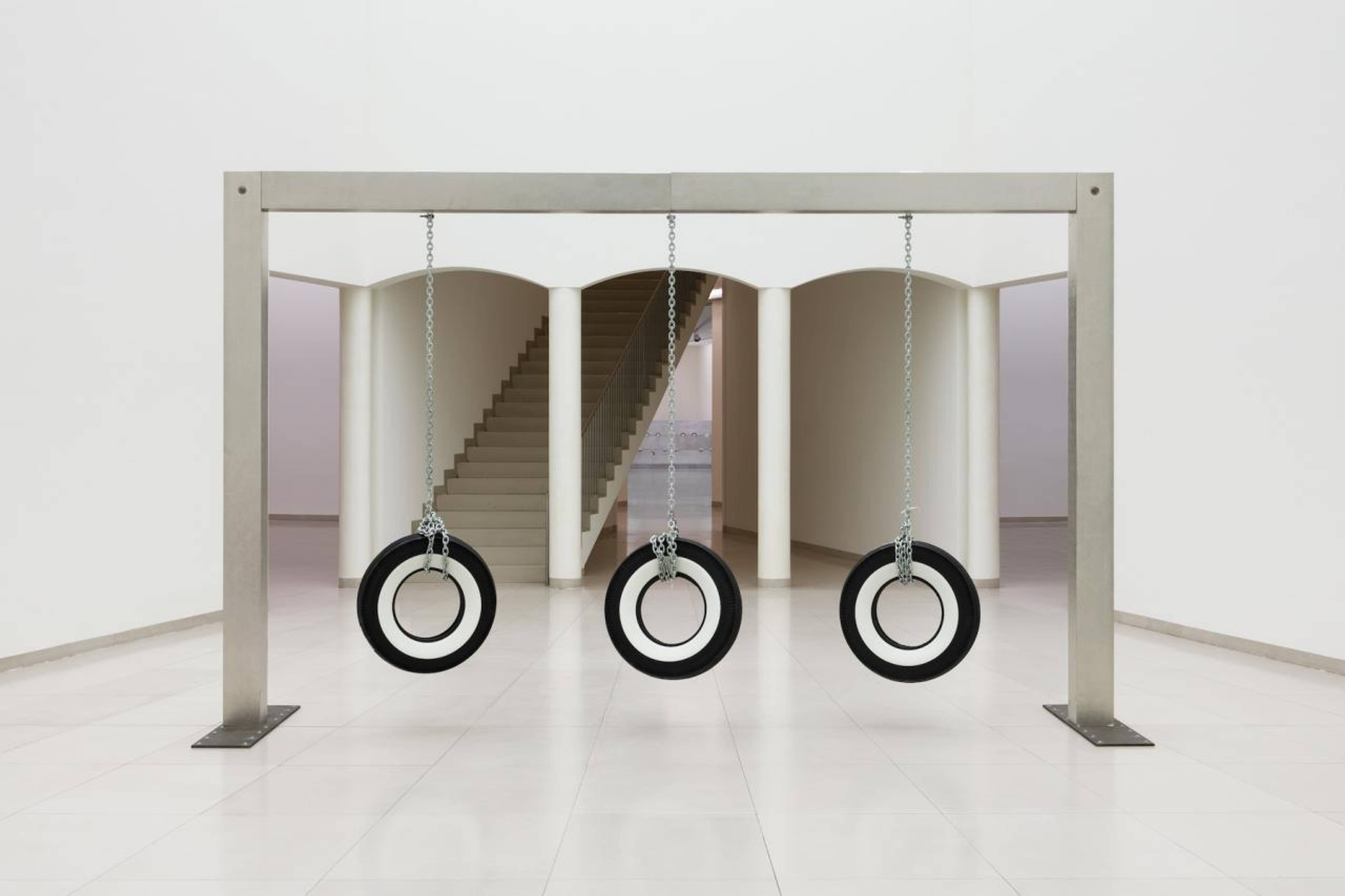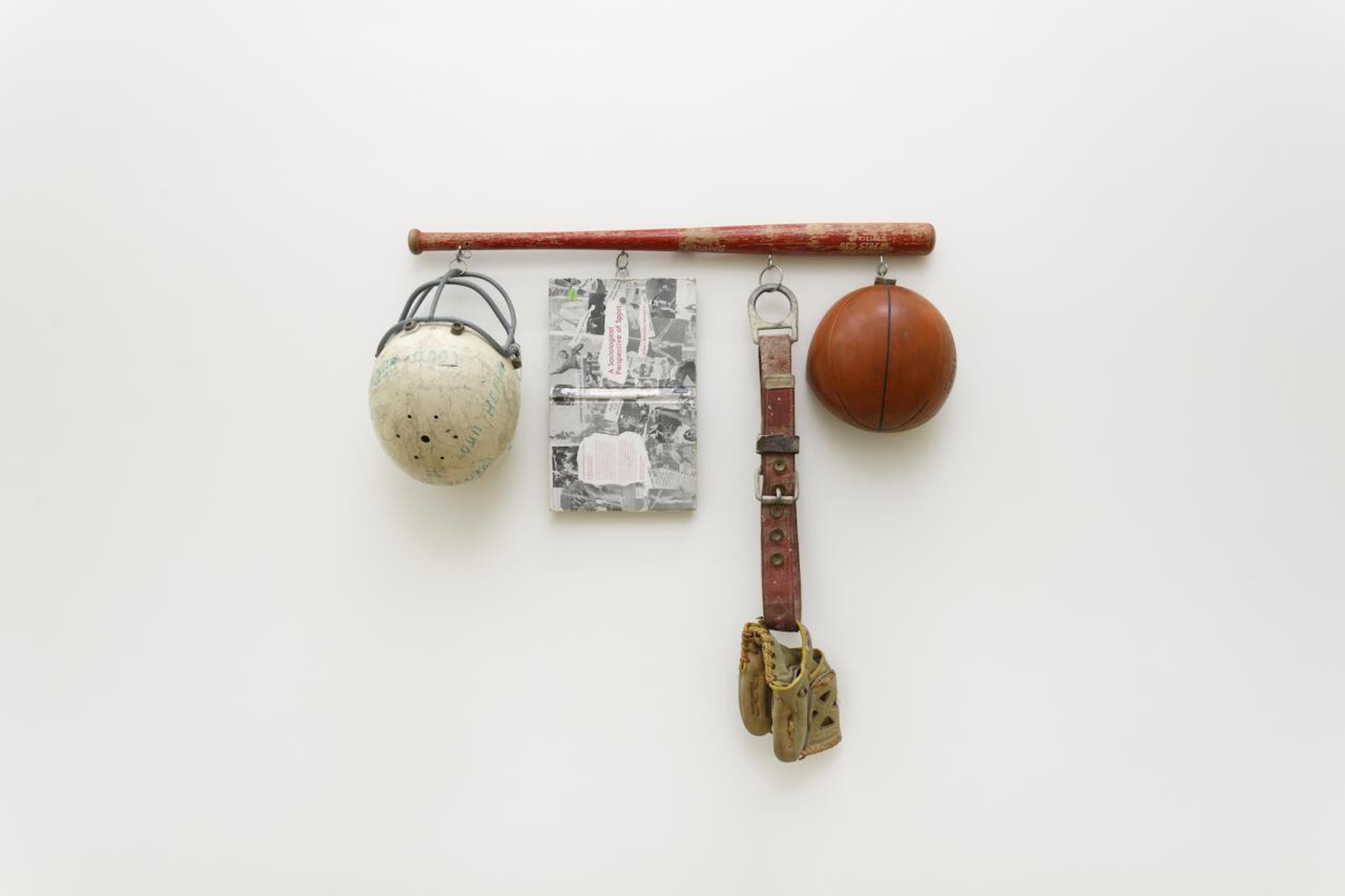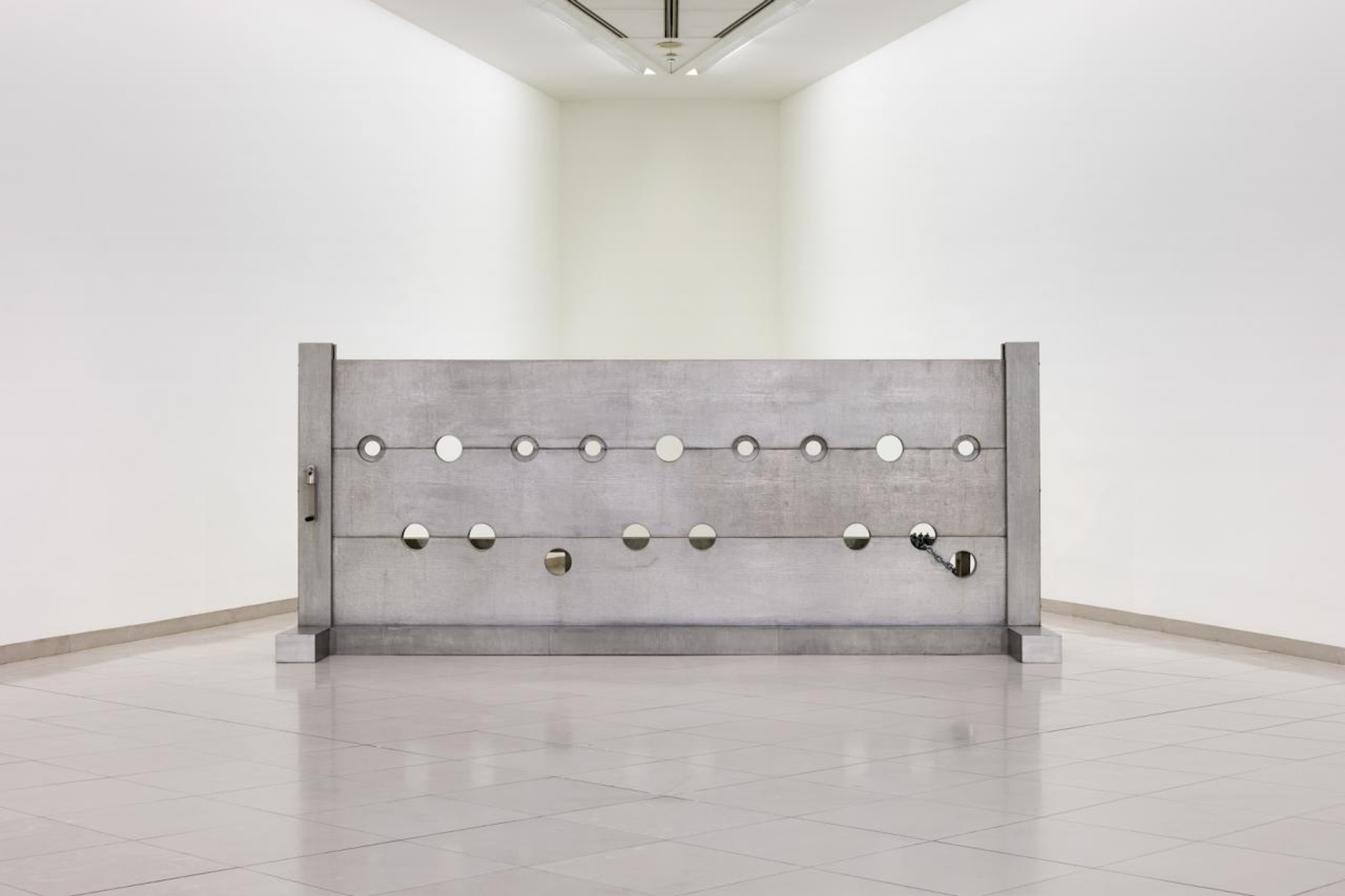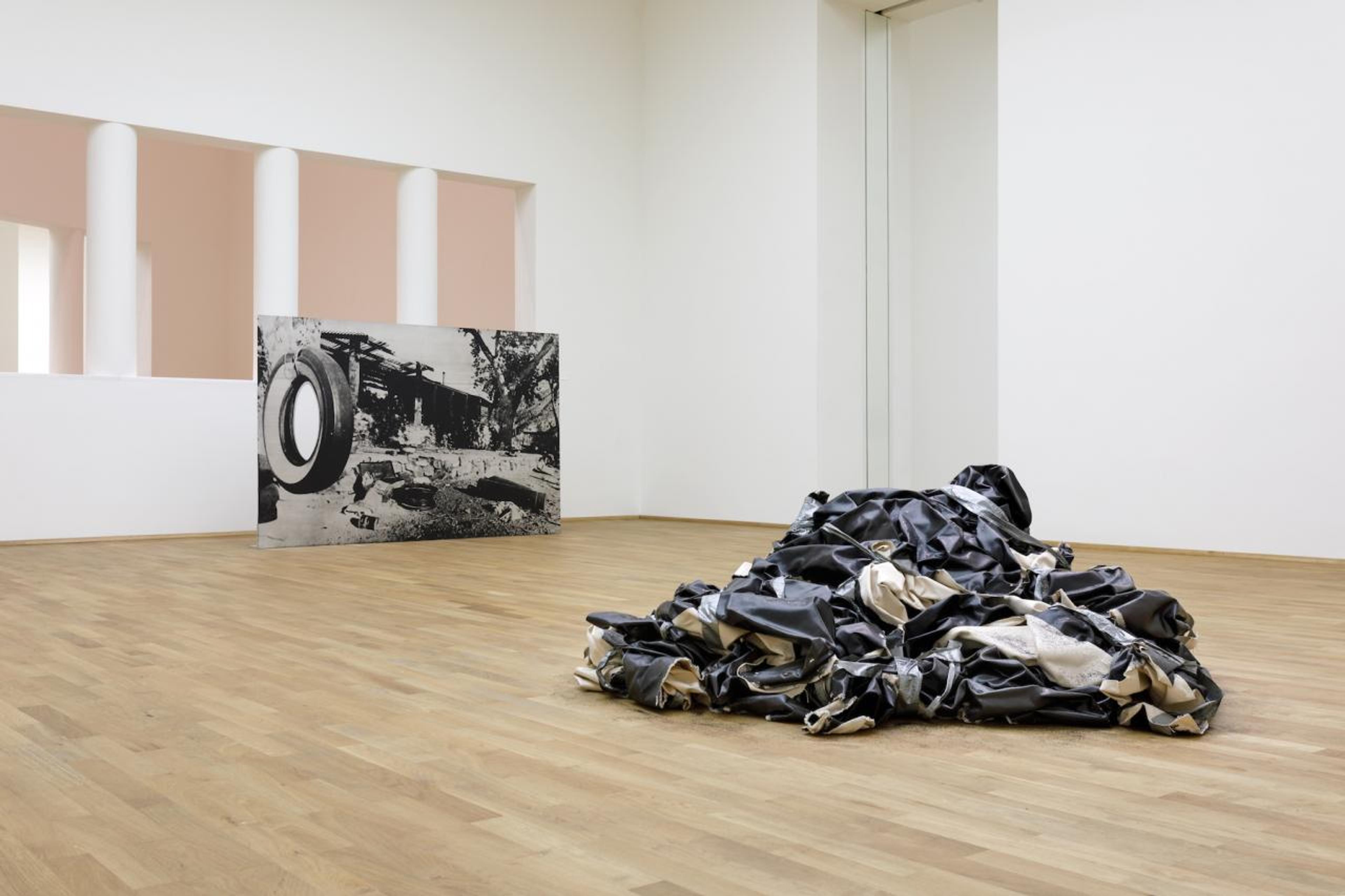On the way to the show, passing a travel agency, there’s a window display with neatly folded American flags and a map of the US printed on a portable movie screen with THE REAL AMERICA against a backdrop of mountain peaks and riders wearing cowboy hats on horseback. In no way evocative of Hannes Schmid's iconic Marlboro Man, by way of Richard Prince, the message is yet clear: the West beckons. Hasn't this been a lure in this part of the world, especially in the corral between 1961 and 1989? And apparently still. But in these scarily autocratic times, with calls for another wall – on America's southern border – in a country nearly as divided as during the Civil War, with torchlit rallies, fascists battling Antifa in the streets, trigger-happy police, a Secretary of Education (a woman) all but chanting “campus rape great again,” what's on offer from the Reisebüro ? “A cheap holiday in other people's misery.” A model airplane on a metal stand, it's tail emblazoned with red, white, and its blue, completes the tempting scene.
There’s also an oversize poster in poster in the street for Cady Noland at the MMK with a pitch-perfect image of Gibbet (1993–94), a sculpture taking its cue from a set of stocks, an instrument of public humiliation harking back to colonial times. The flat, heavy metal structure wrapped in a crisp American flag has five holes to align with openings for the head, arms, and legs of its missing victim, a figure of fun. Even before arriving we've been delivered to the exhibition's doorstep. The pump has been primed. Whether or not any actual representation of the human form appears, this is an artist whose otherwise mute objects speak volumes via body-operating, barriers, restraints, lack of mobility, torture, terror, a gallows humour that conflates play and dread – immediately evidenced in Publyck Sculpture (1994), occupying the very first room. Three tires dangle from metal link chains on a large aluminium-covered structure; Minimalism meets Punishment Park. These could be swings for children on an improvised playground, but more darkly, they recall a recent remark by Mississippi Republican Senator Cindy Hyde-Smith, caught on camera “joking” with a supporter: “If he invited me to a public hanging, I'd be in the first row.“ And we thought the days of lynching were behind us? The chains still rattle.
Cady Noland Model With Entropy (1984) Private collection (FR) Photo: Axel Schneider
The work Noland made between 1984 and 99, when she famously absented herself from the art scene, is so resonant today as to chill one's spine and freeze the brain. That she tapped into the central nervous system of the culture of twenty to thirty years prior doesn't necessarily register as prescient. She wasn't aiming to predict anything, art like a revolver hitting its target, whether shot at point-blank range (Lincoln, Oswald) or by a security camera (Patty Hearst). If her work says anything, it clearly warns: the bad behaviour of sociopaths, psychopaths, and con men has always been with us. These figures persist and thrive – one buoyed all the way to the highest office.
A serial liar and alleged sexual abuser lurches about Noland’s childhood home of Washington DC, a place, as she remarked, where people trash one another “for sport”, this well before Twitter's trolls. Did she predict Trump and waves of mayhem? Of course not. But the celebrity culture she observed, skewering early on, has allowed for the scum, and not the cream, to rise to the top in our hyper-violent time: mass shootings in schools, places of worship, movie theatres. An all-new banality of evil, the "exceptionalism” of the average American loser, ramped up post-9/11.
On the left: Cady Noland, Gibbet (1993/1994) Courtesy The Brant Foundation, Greenwich, Connecticut (US) On the right: Cady Noland, Beltway Terror (1993/1994) Courtesy The Brant Foundation, Greenwich, Connecticut (US) Installation view MUSEUM MMK FÜR MODERNE KUNST; Photo: Axel Schneider
Tower Of Terror (1993), a triple “stretch limo” of stocks, came eight years before passenger jets were flown into the Twin Towers in New York, where Noland lives. Who could have anticipated such an unutterably horrific event? Having stopped travelling years before, Noland would never set foot on a plane again. So what most want to know: Did she cooperate with the production of the exhibition? Yes, by long-distance, and she not only agreed to the show, for which curator and MMK Director Susanne Pfeffer deserves some sort of medal, but Noland also chose the pieces, planned an installation covering all three museum floors, and selected other artists’ works from the museum’s collection to exhibit alongside her own. Seen in relation to her art, that of Joseph Beuys, Bill Bollinger, Claes Oldenburg, Steven Parrino, Charlotte Posenenske, Sturtevant, Andy Warhol, and even a 1963 painting by her father, Kenneth Noland, offer uncanny resonance. A crumpled canvas blob by Parrino, set on the floor in front of Noland's Trashing Folgers (1993–94), might have spilled out from the image of a Manson family hideout, with a tire swing in the foreground, or gruesomely represent the crumpled body of Abigail Folger, one of their victims in the 1969 Sharon Tate murders. Beuys may seem an unlikely choice, but his vitrine contained the boxing gloves and long coiled ropes from the ring in which he staged Boxing Match for Direct Democracy (1972) at documenta 5. In addition to the pugilistic violence that ties in with her own themes of aggression and sport – seen most prominently in Model With Entropy (1984) – she understands that democracy itself is everywhere threatened today. A Warhol “Death and Disaster” silkscreen of prints left at the scene of a crime, its ink as smudged as newsprint on our fingers, seen alongside Noland's forensics makes evident that if anyone is heir to Pop's darkness then it is this artist first of all. That her work of so long ago echoes so strongly with our moment only makes us wonder: where are the artists of today, indicting this time, who we will be looking back on, with a deep, creepy shudder, years from now?
Cady Noland
Museum für Moderne Kunst
27 October 2018 – 31 March 2019
Bob Nickas is a curator and writer based in New york.
– This text appears in Spike Art Quarterly #58 . You can buy it in our online shop –
Cady Noland Tower of Terror (1993) Courtesy Glenstone Museum, Potomac, Maryland (US), Installation view MUSEUM MMK FÜR MODERNE KUNST, Photo: Axel Schneider
Front: Steven Parrino, Bradley „The Beast“ Field R.I.P. (1997) Back: Cady Noland, Trashing Folgers (1993/1994), Collection FRAC Grand Large- Hautsde-France, Dunkerque (FR) Installation view MUSEUM MMK FÜR MODERNE KUNST, © Steven Parrino. Courtesy the Steven Parrino Estate/Gagosian Gallery; Photo: Axel Schneider
_______INSERT_______






